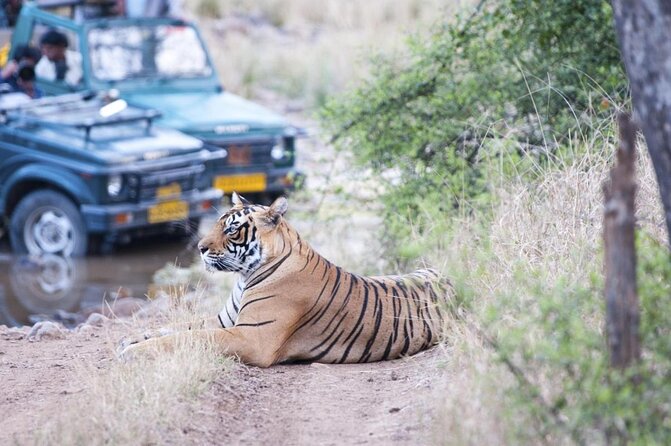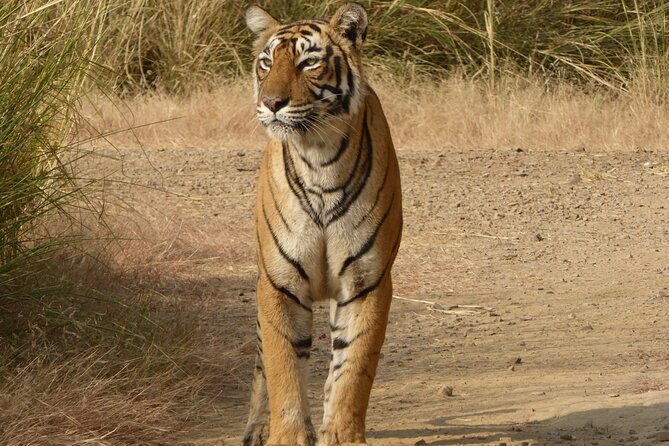Tucked away like a hidden gem in the rugged terrains of India, Ranthambore National Park unfolds a tapestry of wonders waiting to be explored. With its lush landscapes and diverse wildlife, this sanctuary offers a glimpse into the untamed beauty of nature.
But beyond its surface lies a realm of stories and experiences that captivate the soul, inviting visitors to uncover the secrets that make this park a truly unique destination. Prepare to embark on an adventure that transcends mere sightseeing and promises to reveal a world where nature reigns supreme.
Good To Know

- Diverse wildlife and safari experiences offer memorable encounters.
- Optimal visit time from October to March for wildlife sightings.
- Various safari options for exploring ecosystems and spotting animals.
- Accommodation choices cater to diverse preferences near the park.
Wildlife at Ranthambore National Park

Observing the diverse wildlife thriving within Ranthambore National Park is a captivating experience that enthralls visitors with its beauty and untamed allure. Animal sightings are plentiful in this renowned park, with opportunities to spot majestic Bengal tigers, leopards, sloth bears, and a variety of bird species.
Safari experiences within the park offer a thrilling way to encounter these creatures in their natural habitat. Visitors can embark on guided tours through the park, led by experienced naturalists who provide insights into the behavior and habitats of the park’s inhabitants.
The chance to witness these animals up close, going about their daily routines, creates unforgettable memories for all who venture into the heart of Ranthambore National Park.
Find more activities and experiences we've covered in Sawai Madhopur.
Best Time to Visit

The ideal time to visit Ranthambore National Park, renowned for its diverse wildlife, depends on seasonal factors that significantly impact the park’s natural splendor. The timing of your visit can greatly influence the overall experience, ensuring you make the most of your trip.
Weather conditions play a crucial role in determining the best time to visit. The peak season, typically from October to March, offers the most favorable weather for exploring the park. During this time, the temperatures are moderate, making wildlife sightings more likely.
The park remains closed during the monsoon season, from July to September, due to heavy rainfall. Planning your visit during the dry season can enhance your chances of spotting a wide variety of animals in their natural habitat.
Safari Options Available
For an immersive wildlife experience at Ranthambore National Park, visitors can choose from a variety of safari options tailored to explore the park’s diverse ecosystems. Safari experiences at Ranthambore offer thrilling encounters with majestic Bengal tigers, leopards, sloth bears, and a rich array of bird species in their natural habitat. Adventure tours provide the opportunity to witness these animals up close in open vehicles, guided by experienced naturalists who enhance the safari with their knowledge of the park’s flora and fauna.
Visitors can select from morning and afternoon safaris, each offering unique glimpses into the park’s vibrant wildlife. These safari options ensure that guests can maximize their chances of spotting the incredible wildlife that calls Ranthambore home.
Accommodation Choices Nearby
A diverse range of accommodation options awaits visitors near Ranthambore National Park, offering a blend of comfort and proximity to the park’s wildlife. Travelers can choose from a variety of places to stay, catering to different preferences and budgets:
- Luxury Resorts: Pamper yourself in lavish surroundings with top-notch amenities.
- Budget Hotels: Affordable accommodation options without compromising on comfort.
- Boutique Lodges: Experience personalized service and unique decor in intimate settings.
- Tented Camps: Enjoy nature with luxurious tented accommodations.
- Homestays: Stay with local families for an authentic cultural experience near the park.
Each lodging choice provides its charm, ensuring a memorable stay for every visitor exploring the wonders of Ranthambore National Park.
Conservation Efforts in the Park
Conservation efforts in Ranthambore National Park reflect a deep commitment to preserving the delicate balance of its ecosystem and safeguarding the diverse wildlife within its boundaries. Community involvement plays a crucial role in these efforts, with local residents, authorities, and conservation organizations working together to protect the park’s natural resources.
Sustainability initiatives are also a key focus, aiming to ensure that the park’s ecological integrity is maintained for future generations. By promoting responsible tourism practices and implementing conservation programs, Ranthambore National Park strives to create a harmonious coexistence between humans and wildlife.
Through education, awareness campaigns, and effective management strategies, the park continues to make significant strides in its conservation endeavors, setting an example for other wildlife reserves around the world.
Photography Tips for Visitors
Implementing effective photography techniques can greatly enhance visitors’ experiences at Ranthambore National Park, capturing the beauty of its wildlife and landscapes in stunning detail. To make the most of your photography opportunities, consider the following tips:
Utilize Natural Lighting: Early morning and late afternoon offer the best lighting for capturing vibrant images of the park’s inhabitants.
Experiment with Angles: Try different perspectives to add depth and interest to your photos.
Use the Rule of Thirds: Compose your shots by placing subjects off-center for a more visually appealing result.
Focus on Details: Zoom in on the intricate patterns and features of the wildlife for unique shots.
Patience is Key: Wait for the perfect moment to capture authentic and captivating photographs.
Local Culture and Cuisine
Enjoy the vibrant local culture and savor the tantalizing cuisine of Ranthambore National Park, where traditional flavors and customs await to enrich your visit.
Explore the local markets brimming with colorful textiles, handicrafts, and spices, offering a glimpse into the region’s rich heritage.
Don’t miss the opportunity to taste authentic Rajasthani dishes like Dal Baati Churma, a hearty meal of lentils, baked wheat balls, and sweet crumbled bread, or Laal Maas, a spicy mutton curry that packs a flavorful punch.
These traditional dishes are infused with local spices and cooking techniques that have been passed down through generations.
Indulge in the culinary delights of Ranthambore to experience the essence of Rajasthan’s gastronomic traditions.
Common Questions
Can Visitors Bring Their Own Food and Drinks Into Ranthambore National Park?
Visitors can bring their own food and drinks when visiting picnic spots. While some locations may have food vendors, it’s always wise to pack snacks for a day out. Enjoy the convenience of having your favorite treats handy.
Are There Any Restrictions on the Types of Clothing Visitors Can Wear During Safaris in the Park?
When on safari, visitors should adhere to the dress code and cultural norms of the region. Dress appropriately for the weather conditions; wear comfortable and breathable clothing. Avoid bright colors that may startle wildlife.
Is It Possible to Visit Ranthambore National Park Without Joining a Guided Safari Tour?
One can venture into Ranthambore National Park for solo exploration without a guided safari tour. However, for wildlife photography enthusiasts, it’s highly recommended to join a guided tour to ensure safety, maximize sightings, and make the most of the experience.
Are There Any Specific Guidelines for Interacting With the Wildlife in the Park?
When visiting wildlife reserves, travelers must adhere to strict guidelines for wildlife interaction. Respect animal behavior, maintain distance, and prioritize conservation efforts. Wildlife photography is permitted but must not endanger animals or compromise tourist safety.
How Does the Park Handle Emergency Situations, Such as Medical Emergencies or Lost Visitors?
In emergency situations, visitor safety is a top priority. The park has a well-equipped emergency response team trained to handle medical emergencies and locate lost visitors efficiently, ensuring a swift and coordinated resolution.
The Sum Up
Experience the untamed beauty and raw wilderness of Ranthambore National Park, where majestic Bengal tigers roam freely and ancient history meets vibrant biodiversity.
With a range of safari options, accommodations, and conservation efforts, this sanctuary offers a unique opportunity to connect with nature and witness its wonders up close.
Enjoy the rich culture and cuisine of the region, and prepare for a truly unforgettable adventure in the heart of India.
More Tour Reviews in Sawai Madhopur
- Ranthambore Safari Booking-Sharing Gypsy and Sharing Canter
- Ranthambore: Sharing Tiger Safari In Canter Or Gypsy Vehicle
- Ranthambhore: Ranthambhore Tiger Reserve Booking
- Ranthambore Crocodile Safari – Village Walk | Hi-Tea | Boat Ride | Open Jeeps
- Private Transfers Between Sawai Madhopur Railway Station to Hotels Drop
- Private Transfers Sawai Madhopur To Bharatpur Drop
Looking for something different? Other Sawai Madhopur activities we've written about
- Ranthambore Safari Booking-Sharing Gypsy and Sharing Canter
- Ranthambore: Sharing Tiger Safari In Canter Or Gypsy Vehicle
- Ranthambhore: Ranthambhore Tiger Reserve Booking
- 2 Best Tours In Sawai Madhopur
- 10 Best Safari Tours In Sawai Madhopur
- 6 Best Private Driver Services In Sawai Madhopur
- 3 Best 3 Hour Tours and Experiences in Sawai Madhopur
- Ranthambore Crocodile Safari – Village Walk | Hi-Tea | Boat Ride | Open Jeeps
- Private Transfers Between Sawai Madhopur Railway Station to Hotels Drop
- Private Transfers Sawai Madhopur To Bharatpur Drop
- One Way Transfer From Ranthambore To Jaipur in AC Vehicle
- Private Transfers Sawai Madhopur To Udaipur Drop
